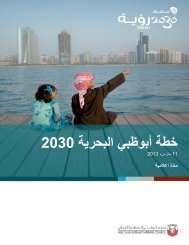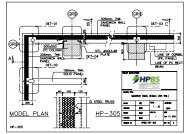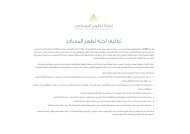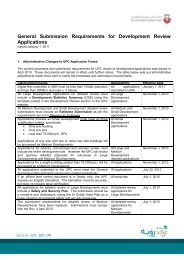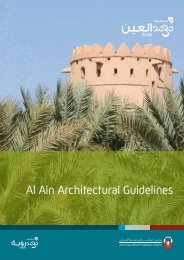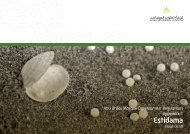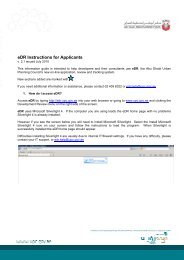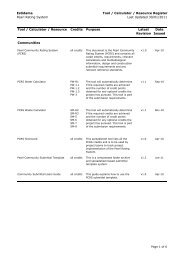Abu Dhabi Urban Planning Council Magazine Issue 6 April 2012
Abu Dhabi Urban Planning Council Magazine Issue 6 April 2012
Abu Dhabi Urban Planning Council Magazine Issue 6 April 2012
You also want an ePaper? Increase the reach of your titles
YUMPU automatically turns print PDFs into web optimized ePapers that Google loves.
Who is Sorouh?<br />
Established in June 2005, and with capital of<br />
AED 2.5bn, Sorouh is now one of the largest<br />
real estate developers listed on the <strong>Abu</strong> <strong>Dhabi</strong><br />
Securities Exchange. As part of Sorouh’s<br />
partnership with the <strong>Abu</strong> <strong>Dhabi</strong> Government in<br />
its Plan 2030, the Company has been awarded<br />
the contract to master plan three investment<br />
zones in <strong>Abu</strong> <strong>Dhabi</strong> – Lulu Island; Shams <strong>Abu</strong><br />
<strong>Dhabi</strong> on Al Reem; and SeihSdeirah, the site of<br />
the Alghadeer development.<br />
What is Sorouh’s mission?<br />
Our day-to-day mission is to develop places<br />
that are significant and bring balance to the<br />
lives of people and society. Like the founders<br />
of <strong>Abu</strong> <strong>Dhabi</strong>, we are able to understand what<br />
differentiates the Emirate from any other<br />
place, so we try to create places that influence<br />
everyone associated with the city in a positive<br />
and measured way.<br />
What are the key features of all<br />
your developments regarding<br />
liveability?<br />
‘Community Liveability’ refers to the<br />
environmental and social quality of an area as<br />
perceived by residents, visitors and employees,<br />
which include: health and safety; local<br />
environmental conditions; the quality of social<br />
interaction; and others.<br />
In our developments, we endeavour to<br />
design and implement the urban components<br />
which help achieving the principle above, for<br />
example, the hierarchy of open and green<br />
spaces as well as the availability of community<br />
facilities and amenities, which are located<br />
within a reasonable walking distances and<br />
connected through nicely landscaped and<br />
shaded pedestrian and cycling networks. We<br />
are always keen to create ‘places that matter’.<br />
Which of the UPC Standards and<br />
Manuals are utilised in Sorouh’s<br />
development projects?<br />
All manuals and design guidelines issues by<br />
UPC are very helpful and are being utilised in<br />
Sorouh developments.<br />
•The <strong>Abu</strong> <strong>Dhabi</strong> <strong>Urban</strong> Street Design Manual<br />
helps in creating nicely landscaped pedestrian<br />
and cycle ways and provides clear guidelines<br />
to organise on-street parking.<br />
•The <strong>Abu</strong> <strong>Dhabi</strong> Public Realm Design Manual<br />
helps creating a hierarchy of vibrant public<br />
open spaces within our developments.<br />
•The <strong>Abu</strong> <strong>Dhabi</strong> Utility Corridor Design Manual<br />
helps in the coordination and layout of utilities<br />
networks.<br />
Q&A<br />
Vision <strong>Magazine</strong> met with Fahad Al<br />
Ketbi, Chief Commercial Officer at<br />
Sorouh, one of <strong>Abu</strong> <strong>Dhabi</strong>’s largest<br />
listed real estate developers.<br />
What are the most important<br />
factors for consideration during<br />
the design and construction of<br />
Sorouh’s developments?<br />
During the design of Sorouh developments, the<br />
most important factor for consideration is to<br />
understand and respond to the requirements<br />
and aspirations of the future users, by creating<br />
liveable and sustainable communities through<br />
innovative ideas and unique products.<br />
During construction, our main focus is the<br />
implementation of top-of-the-line technologies<br />
and construction practices, to achieve the best<br />
possible quality and to reduce any negative<br />
impacts on the environment.<br />
How does Sorouh contribute and<br />
adhere to Plan Capital 2030,<br />
Plan Al Ain 2030 and Plan Al<br />
Gharbia 2030 and the wider<br />
Vision 2030?<br />
SOROUH is committed to Plan Capital 2030,<br />
Plan Al Ain 2030 and Plan Gharbia 2030, as<br />
positively reflected in all our projects being<br />
executed in <strong>Abu</strong> <strong>Dhabi</strong>, Al Ain and the Western<br />
Region and of course, all Sorouh developments<br />
adhere to and respect the wider vision 2030.<br />
Do Sorouh’s projects comply<br />
with Estidama principles of<br />
sustainability across the four<br />
pillars (economy, environment,<br />
culture, society) and with the<br />
Pearl Rating System?<br />
Sorouh is committed to promoting the<br />
sustainability agenda of <strong>Abu</strong> <strong>Dhabi</strong> Government.<br />
Sorouh Developments do comply with the<br />
Estidama principles and the implementation of<br />
the mandatory and optional requirements of<br />
the Pearl Rating System. We understand and<br />
appreciate the benefits of its implementation<br />
on the development of <strong>Abu</strong> <strong>Dhabi</strong> as a<br />
sustainable place.<br />
23 VISION MAGAZINE ISSUE SIX



